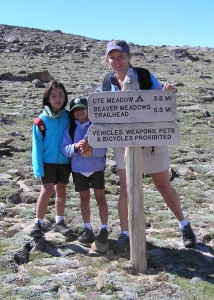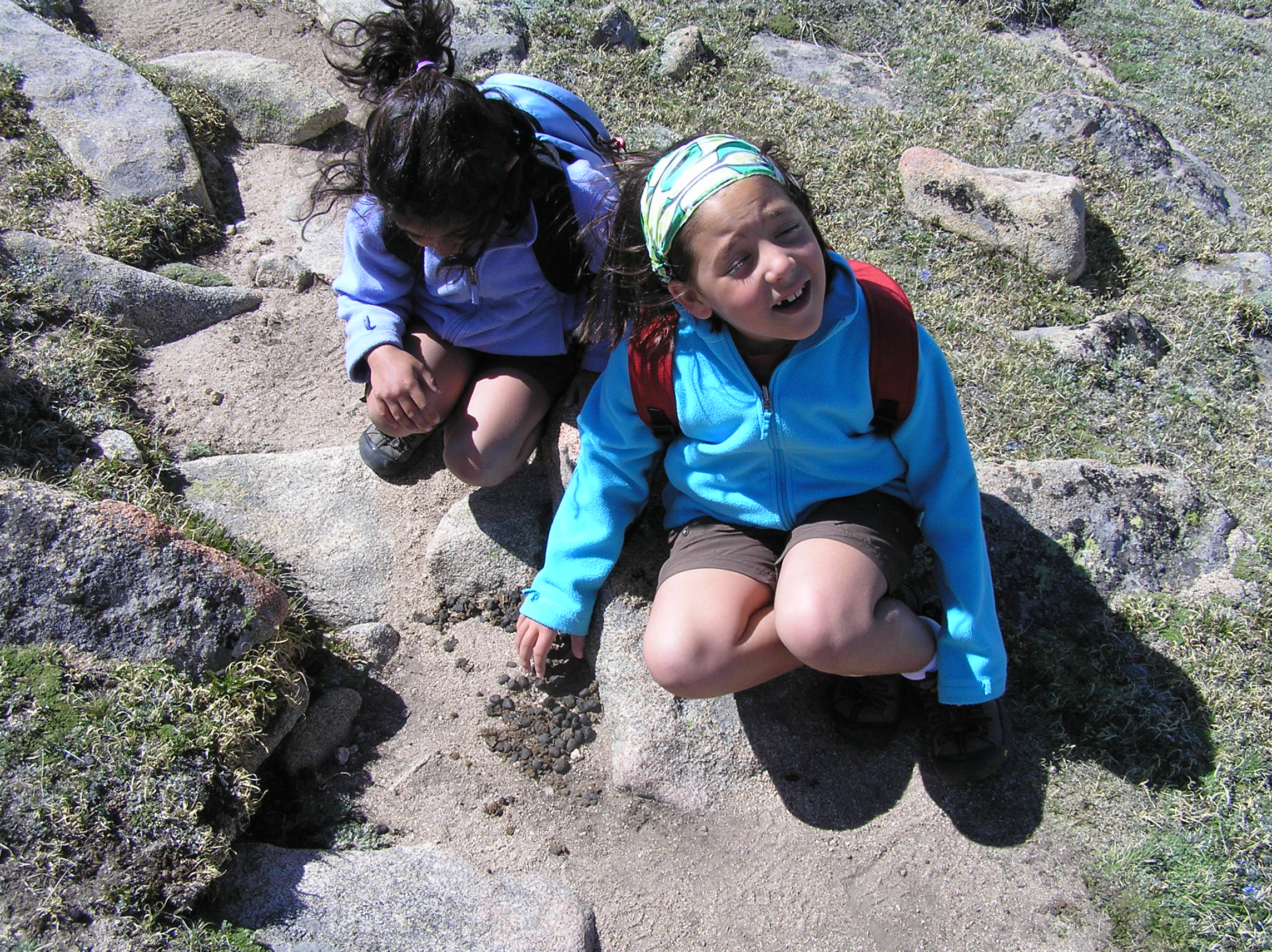You know hiking is good for your health. But do you know just how good it is? If you are heading out for a hike this Memorial Day weekend, take note of all the good you are doing for your body.

Ute Trail, Rocky Mountain National Park
For adults, regular aerobic exercise such as hiking leads to:
- Improved cardio-respiratory fitness (heart, lungs, blood vessels)
- Improved muscular fitness
- Lower risk of coronary heart disease and stroke
- Lower risk of high blood pressure and type 2 diabetes
- Lower risk of high cholesterol and triglycerides
- Lower risk of colon and breast cancer, and possibly lung and endometrial cancer
- Increased bone density or a slower loss of density
- Reduced depression and better quality sleep
- Lower risk of early death (If you are active for 7 hours a week, your risk of dying early is 40% lower than someone active for less than 30 minutes a week.)
- Weight control; hiking burns up 370 calories an hour (154-lb person)

Elk poop! On the trail!
Kids get many of the same benefits, including:
- Improved cardiorespiratory and muscular fitness
- Better bone health
- Less chance of becoming overweight
- Less chance of developing risk factors for heart disease, high blood pressure and type 2 diabetes
- Possibly reduced risk of depression and feeling less stress, more ready to learn in school
- Sleeping better at night
What’s more, hiking exercises almost every part of your body: legs, knees, ankles, arms, hips and butt, abdominals, shoulders and neck. “Hiking exercises your body and your mind, and nourishes your imagination,” says Ignacio Malpica, a certified fitness instructor and personal trainer in Boulder, Colorado. “It creates awareness in your eyes and ears and the rest of your senses.”
How Much Time?
How much activity do you need to reap these incredible health benefits? Experts say getting active for just 150 minutes a week – doing “moderate-intensity” aerobic exercise such as moderate hiking or brisk walking – leads to most of these benefits (reducing risks of colon and breast cancer requires another hour a week). That’s only 2½ hours a week. And you don’t have to do it all at once. Sneaking in a lunchtime hike up the hill near your office counts toward your total, as long as you’re active for at least ten minutes.
If you take part in more vigorous aerobic activities, such as running, dancing, or hiking uphill or with a heavy pack, you need only half that amount of time, or 75 minutes a week, to get health benefits.
What’s moderate exercise? You can talk, but you can’t sing during the activity. Vigorous? You can’t say more than a few words with pausing for breath. “When you are doing moderate exercise, you can continue for a long time, and you are breathing rhythmically,” explains Malpica. “With vigorous exercise, you can’t do it for more than a few minutes at a time.”
And if you rack up even more time, the benefits keep growing too. For even more substantial health benefits, such as an even lower risk of heart disease, aim for 300 minutes of moderate-intensity aerobic exercise, or 150 minutes of vigorous-intensity aerobic exercise each week.
Of course, there are other kinds of physical activity. It’s also important to do some muscle-strengthening activities, such as lifting weights or doing push-ups. The experts say do those at least twice a week. You also need to get in some bone-strengthening activity, which occurs when force on your bones promotes bone growth and strength. Here again, hiking fits the bill.
Another plus: you don’t have to be in perfect shape to start. Even if you are overweight, getting physical can lead to health benefits. But don’t run out and climb a 14er if you’ve long been inactive. The experts say if you’re 35 or older and have been inactive for several years, or you already have a condition such as high blood pressure, check with your doctor first. “Hiking is a great way to start exercising,” says Malpica. “Start with easy hikes and work up to steeper hikes that work your legs more.”
Kids (age 6-17) need 60 minutes of physical activity each day, mostly aerobic. They also need regular muscle-strengthening (playing on playground equipment, climbing trees) and bone-strengthening (running, playing basketball, jumping rope) exercise.
Track Your Workouts
Keeping track of your activity can help you rack up the minutes. Note what you did as well as the length of each workout, and tally it up at the end of the week. Watching your progress can be a great motivator.
Use a calendar to track your workouts. Or try one of the many online options, such as MapMyHike.com, where you can map your own hikes and share your routes with others. Other activity trackers can be found at the 2008 Physical Guidelines for Americans report.
For More Information
2008 Physical Activity Guidelines for Americans; US Department of Health and Human Services
Exercise for Children; MedlinePlus, National Institutes of Health
Kids and Exercise; Kids Health, The Nemours Foundation
Your Guide to Physical Activity and Your Heart; U.S. Department of Health and Human Services
You know hiking is good for your health. But do you know just how good it is?
For adults, regular aerobic exercise such as hiking leads to:
· Improved cardiorespiratory fitness (heart, lungs, blood vessels)
· Improved muscular fitness
· Lower risk of coronary heart disease and stroke
· Lower risk of high blood pressure and type 2 diabetes
· Lower risk of high cholesterol and triglycerides
· Lower risk of colon and breast cancer, and possibly lung and endometrial cancer
· Increased bone density or a slower loss of density
· Reduced depression and better quality sleep
· Lower risk of early death (If you are physically active for 7 hours a week, your risk of dying early is 40% lower than someone active for less than 30 minutes a week.)
· Weight control; hiking burns up 370 calories an hour (154-lb person); and it works almost every part in your body: legs, knees, ankles, arms, hips and butt, abdominals, shoulders and neck.
Kids get many of the same benefits, including:
· Improved cardiorespiratory and muscular fitness
· Better bone health
· Less chance of becoming overweight
· Less chance of developing risk factors for heart disease, high blood pressure and type 2 diabetes
· Possibly reduced risk of depression and feeling less stress, more ready to learn in school
- Sleeping better at night
How much activity do you need to reap these incredible health benefits? Experts say getting active for just 150 minutes a week – doing “moderate-intensity” aerobic exercise such as moderate hiking or brisk walking – leads to most of these benefits (reducing risks of colon and breast cancer requires another hour a week). That’s only 2½ hours a week. And you don’t have to do it all at once. Sneaking in a lunchtime hike up the hill behind your office counts toward your total, as long as you’re active for at least ten minutes.
If you take part in more vigorous aerobic activities, such as running, dancing, or hiking uphill or with a heavy pack, you need only half that amount of time, or 75 minutes a week, to get health benefits. Two minutes of moderate-intensity exercise equals one minute of vigorous-intensity exercise. (What’s moderate? You can talk, but you can’t sing during the activity. Vigorous? You can’t say more than a few words with pausing for breath.)
And if you rack up even more time, the benefits keep growing too. For even more substantial health benefits, such as an even lower risk of heart disease, aim for 300 minutes of moderate-intensity aerobic exercise, or 150 minutes of vigorous-intensity aerobic exercise each week.
Of course, there are other kinds of physical activity. It’s also important to do some muscle-strengthening activities, such as lifting weights or doing push-ups. The experts say do those at least twice a week. You also need to get in some bone-strengthening activity, which occurs when force on your bones promotes bone growth and strength. Here again, hiking fits the bill.
Another plus: you don’t have to be in perfect shape to start. Even if you are overweight, getting physical can lead to health benefits. But don’t run out and climb a 14er if you’ve long been inactive. The experts say if you’re over 35 and have been inactive for several years, or you already have a condition such as high blood pressure, check with your doctor first.
Kids (age 6-17) need 60 minutes of physical activity each day, mostly aerobic. They also need regular muscle-strengthening (playing on playground equipment, climbing trees) and bone-strengthening (running, playing basketball, jumping rope) exercise.
Track Your Workouts
Keeping track of your activity can help you rack up the minutes. Note what you did as well as the length of each workout, and tally it up at the end of the week. Seeing your progress can be a great motivator.
Use a calendar to track your workouts. Or try one of the many online options, such as MapMyHike.com, where you can map your own hikes as well as share your routes with others. Other activity trackers can be found at the 2008 Physical Guidelines for Americans report http://www.health.gov/Paguidelines/adultguide/keepingtrack.pdf .









I can’t agree more that hiking gets you physically fit in all the ways you mention and it also has a great bonus and that is it gets you mentally fit, you leave behind all the everyday pressures and pretty much can recharge your batteries just by going for a hike.
I think everyone would be better off if they just spent some time in the bush enjoying life a little more.
My brother had a heart attack last year, somehow, I need to convince him to hike the Rocky Mountains with me here in Utah, rain sleet or snow, he needs more cardiovascular work outs!
GREAT article. I think Colorado has some of the best hiking in the world and most of us don’t have to go far to find it. I love hiking the Devil’s Backbone just ten minutes from my house and it’s a real hike that will kick a novice’s butt!
Thanks, Heidi! Hiking really is a wonderful activity — a great workout for body AND the mind.